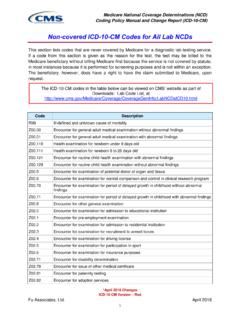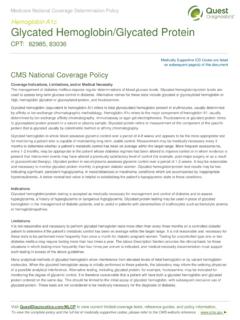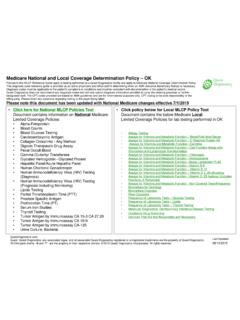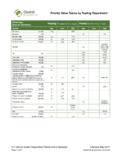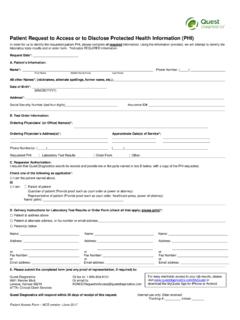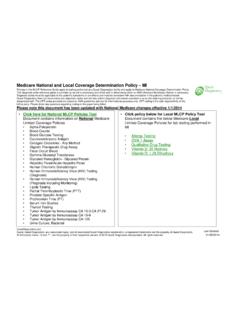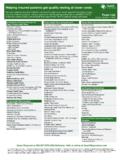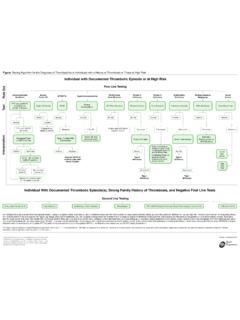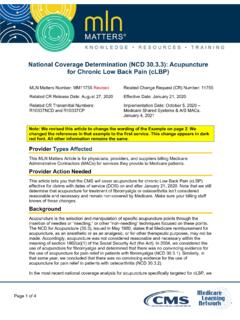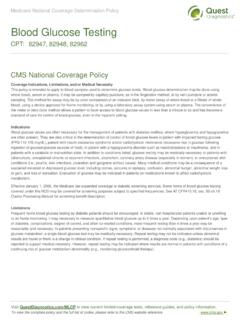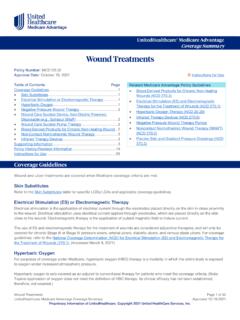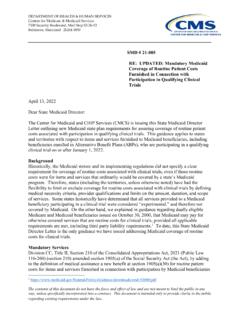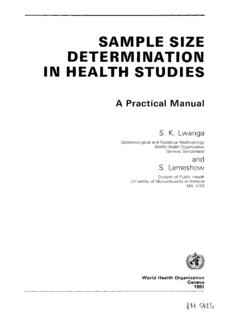Transcription of Medicare National Coverage Determination Policy Blood …
1 CPT: Medicare National Coverage Determination PolicyCMS National Coverage PolicyVisit view current limited Coverage tests, reference guides, and Policy view the complete Policy and the full list of codes, please refer to the CMS website reference85004, 85007, 85008, 85013, 85014, 85018, 85025, 85027, 85032, 85048, 85049 Blood CountsCBCC overage Indications, Limitations, and/or Medical NecessityBlood counts are used to evaluate and diagnose diseases relating to abnormalities of the Blood or bone marrow. These include primary disorders such as anemia, leukemia, polycythemia, thrombocytosis and thrombocytopenia.
2 Many other conditions secondarily affect the Blood or bone marrow, including reaction to inflammation and infections, coagulopathies, neoplasms and exposure to toxic substances. Many treatments and therapies affect the Blood or bone marrow, and Blood counts may be used to monitor treatment complete Blood count (CBC) includes a hemogramand differential white Blood count (WBC). The hemogramincludes enumeration of red Blood cells, white Blood cells, and platelets, as well as the Determination of hemoglobin, hematocrit, and symptoms of hematological disorders are often nonspecific, and are commonly encountered in patients who may or may not proveto have a disorder of the Blood or bone marrow.
3 Furthermore, many medical conditions that are not primarily due to abnormalitiesof Blood or bone marrow may have hematological manifestations that result from the disease or its treatment. As a result, the CBC is one of the most commonly indicatedlaboratory patients with possible hematological abnormalities, it may be necessary to determine the hemoglobin and hematocrit, to calculate the red cell indices, and to measure the concentration of white Blood cells and platelets. These measurements are usually performed on a multichannel analyzer that measures all ofthe parameters on every sample.
4 Therefore, laboratory assessments routinely include these for a CBC or hemograminclude red cell, platelet, and white cell disorders. Examples of these indications are enumerated individually for a CBC generally include the evaluation of bone marrow dysfunction as a result of neoplasms, therapeutic agents, exposure to toxic substances, or pregnancy. The CBC is also useful in assessing peripheral destruction of Blood cells, suspectedbone marrow failure or bone marrow infiltrate, suspected myeloproliferative, myelodysplastic, or lymphoproliferative processes, and immune for hemogramor CBC related to red cell (RBC)
5 Parameters of the hemograminclude signs, symptoms, test results, illness, or disease that can be associated with anemia or other red Blood cell disorder ( , pallor, weakness, fatigue, weightloss, bleeding, acute injury associated with Blood loss or suspected Blood loss, abnormal menstrual bleeding, hematuria, hematemesis, hematochezia, positive fecal occult Blood test, malnutrition, vitamin deficiency, malabsorption, neuropathy, known malignancy, presence of acute or chronic disease that may have associated anemia, coagulation or hemostatic disorders, postural dizziness, syncope, abdominal pain, change in bowel habits, chronic marrow hypoplasia or decreased RBC production, tachycardia, systolicheart murmur, congestive heart failure, dyspnea, angina, nailbed deformities, growth retardation, jaundice, hepatomegaly, splenomegaly, lymphadenopathy, ulcers on the lower extremities).
6 For hemogramor CBC related to red cell (RBC) parameters of the hemograminclude signs, symptoms, test results, illness, or disease that can be associated with polycythemia (for example, fever, chills, ruddy skin, conjunctival redness, cough, wheezing, cyanosis, clubbing of the fingers, orthopnea, heart murmur, headache, vague cognitive changes including memory changes, sleep apnea, weakness, pruritus, dizziness, excessive sweating, visual symptoms, weight loss, massive obesity, gastrointestinal bleeding, paresthesias, dyspnea, joint symptoms, epigastric distress, pain and erythema of the fingers or toes.)
7 Venous or arterial thrombosis, thromboembolism, myocardial infarction, stroke, transient ischemic attacks, congenital heart disease, chronic obstructive pulmonary disease, increased erythropoietin production associated with neoplastic, renal or hepatic disorders, androgen or diuretic use, splenomegaly, hepatomegaly, diastolic hypertension.) Medicare National Coverage Determination PolicyVisit view current limited Coverage tests, reference guides, and Policy view the complete Policy and the full list of codes, please refer to the CMS website referenceCMS National Coverage Policy (continued)CPT.
8 Blood indications for CBC with differential count related to the WBC include signs, symptoms, test results, illness, or disease associated with leukemia, infections or inflammatory processes, suspected bone marrow failure or bone marrow infiltrate, suspected myeloproliferative, myelodysplastic or lymphoproliferative disorder, use of drugs that may cause leukopenia, and immune disorders ( , fever, chills, sweats, shock, fatigue, malaise, tachycardia, tachypnea, heart murmur, seizures, alterations of consciousness, meningismus, pain such as headache, abdominal pain, arthralgia, odynophagia, or dysuria, redness or swelling of skin, soft tissue bone, or joint, ulcers of the skin or mucous membranes, gangrene, mucous membrane discharge, bleeding, thrombosis, respiratory failure, pulmonary infiltrate, jaundice, diarrhea, vomiting, hepatomegaly, splenomegaly, lymphadenopathy, opportunistic infection, such as oral candidiasis.)
9 Indications for CBC related to the platelet count include signs, symptoms, test results, illness, or disease associatedwith increased or decreased platelet production and destruction, or platelet dysfunction ( , gastrointestinal bleeding, genitourinary tract bleeding, bilateral epistaxis, thrombosis, ecchymosis, purpura, jaundice, petechiae, fever, heparin therapy, suspected DIC, shock, pre-eclampsia, neonate with maternal ITP, massive transfusion, recent platelet transfusion, cardiopulmonary bypass, hemolytic uremic syndrome, renal diseases, lymphadenopathy, hepatomegaly, splenomegaly, hypersplenism, neurologic abnormalities, viral or other infection, myeloproliferative, myelodysplastic, or lymphoproliferative disorder, thrombosis, exposure to toxicagents, excessive alcohol ingestion, autoimmune disorder (SLE, RA).)
10 For hemogramor CBC related to red cell (RBC) parameters of the hemograminclude, in addition to those already listed, thalassemia, suspected hemoglobinopathy, lead poisoning, arsenic poisoning, and indications for CBC with differential count related to the WBC include, in addition to those already listed, storagediseases; mucopolysaccharidoses, and use of drugs that cause leukocytosis such as G-CSF or indications for CBC related to platelet count include, in addition to those already listed, May-Hegglinsyndrome and Wiskott-Aldrich syndrome. of patients who are asymptomatic, or who do not have a condition that could be expected to result in a hematological abnormality, is screening and is not a covered some circumstances it may be appropriate to perform only a hemoglobin or hematocrit to assess the oxygen carrying capacityof the Blood .
